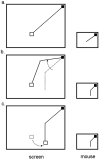Proprioceptive deafferentation slows down the processing of visual hand feedback
- PMID: 18217852
- PMCID: PMC2570484
- DOI: 10.1167/7.5.12
Proprioceptive deafferentation slows down the processing of visual hand feedback
Abstract
During visually guided movements both vision and proprioception inform the brain about the position of the hand, so interaction between these two modalities is presumed. Current theories suggest that this interaction occurs by sensory information from both sources being fused into a more reliable, multimodal, percept of hand location. In the literature on perception, however, there is evidence that different sensory modalities interact in the allocation of attention, so that a stimulus in one modality facilitates the processing of a stimulus in a different modality. We investigated whether proprioception facilitates the processing of visual information during motor control. Subjects used a computer mouse to move a cursor to a screen target. In 28% of the trials, pseudorandomly, the cursor was rotated or the target jumped. Reaction time for the trajectory correction in response to this perturbation was compared under conditions with normal and reduced proprioception after 1-Hz rTMS over the hand-contralateral somatosensory cortex. Proprioceptive deafferentation slowed down the reaction time for initiating a motor correction in response to a visual perturbation in hand position, but not to a target jump. Correlation analyses suggested that reaction time was influenced by the size of the visual error rather than the visuo-proprioceptive conflict or the variance in cursor position. We suggest that during movements intact proprioception is necessary for the rapid processing of visual feedback.
Figures



References
-
- Kennett S, Eimer M, Spence C, Driver J. Tactile-visual links in exogenous spatial attention under different postures: convergent evidence from psychophysics and ERPs. J Cogn Neurosci. 2001;13:462–78. - PubMed
-
- Lisanby SH, Gutman D, Luber B, Schroeder C, Sackeim HA. Sham TMS: intracerebral measurement of the induced electrical field and the induction of motor-evoked potentials. Biol Psychiatry. 2001;49:460–3. - PubMed
-
- McDonald JJ, Teder-Salejarvi WA, Hillyard SA. Involuntary orienting to sound improves visual perception. Nature. 2000;407:906–8. - PubMed
-
- Pelisson D, Prablanc C, Goodale MA, Jeannerod M. Visual control of reaching movements without vision of the limb. II. Evidence of fast unconscious processes correcting the trajectory of the hand to the final position of a double-step stimulus. Exp Brain Res. 1986;62:303–11. - PubMed
Publication types
MeSH terms
Grants and funding
LinkOut - more resources
Full Text Sources
Medical

